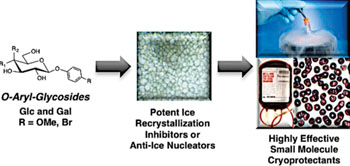Cryopreservation Improves Longer-Lasting Blood Supply
By LabMedica International staff writers
Posted on 01 Dec 2016
The development of highly efficient methods to cryopreserve cells, tissues, and organs is becoming exceedingly important to meet the increasing demands of emerging cellular therapies. Cryopreservation of blood and stem cells has had tremendous impact on regenerative and transfusion medicine.Posted on 01 Dec 2016
Currently, red blood cell (RBC) storage is limited to 42 days at 4 °C, which can result in blood shortages when high numbers of emergency transfusions are required. Although cryopreservation can extend the storage time to 10 years, major limitations to current protocols largely limit this preservation method to rare blood types and autologous RBCs.

Image: The cryopreservation of red blood cells using novel molecules (Photo courtesy of the American Chemical Society).
Biochemists working with the Canadian Blood Services (Edmonton, AB, Canada) have examined a new class of small molecules with the potential to make the cryopreservation process more practical and give the cells and tissues a longer shelf life. Low-molecular-weight ice recrystallization inhibitors (IRIs) are ideal cryoprotectants that control the growth of ice and mitigate cell damage during freezing.
The team performed a detailed study correlating the ice recrystallization inhibition activity and the cryopreservation ability with the structure of O-aryl-glycosides. Many effective IRIs are efficient cryoadditives for the freezing of red blood cells (RBCs). One effective cryoadditive did not inhibit ice recrystallization but instead inhibited ice nucleation, demonstrating the significance of inhibiting both processes and illustrating the importance of this emerging class of cryoprotectants.
The team showed that two of the molecules in the class were effective at preventing ice from forming in red blood cells frozen at -80 °C. Adding the new protectants reduced the needed concentration of glycerol from 40% to between 10% and 15%. Lowering the amount of glycerol could help minimize the time required to prepare thawed red blood cells for transfusion, and thus, be ready for use in patients faster.
The authors concluded that the O-aryl-glycosides represent a novel class of small-molecule IRIs, many of which were effective cryoadditives used for the freezing of RBCs with reduced glycerol concentrations. The synthesis of these structurally simple molecules is amenable to large-scale preparation for use in cryopreservation applications to improve upon cryopreservation protocols of therapeutically important cells. The study was published on October 24, 2016, in the journal ACS Omega.
Related Links:
Canadian Blood Services













